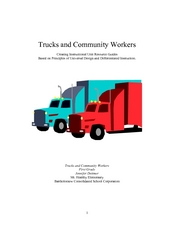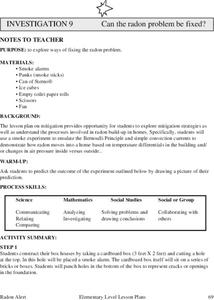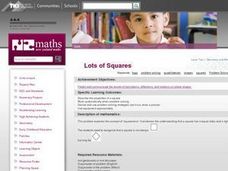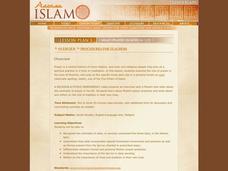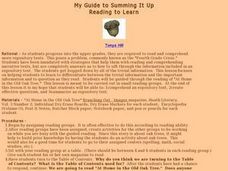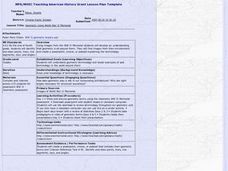Curated OER
Preparing for Poetry: A Reader's First Steps
Students complete poetry analysis using William Shakespeare's "Sonnet 130" as a part of a study of figurative language. In this Shakespearean language lesson plan, students define literal and figurative language and practice paraphrasing...
Curated OER
Trucks and Community Workers
First graders identify community helpers and their roles. In this transportation lesson, 1st graders complete a series of lessons integrating technology and literacy. Students decode sounds of short u, c/s/ and g/j/ words and improve...
Curated OER
Who's Sharing Our Stories on "The Hill"?
Students explore parliamentary structure. They study the roles & responsibility of key players or representatives. This lesson presents a wide variety of rich activities students can engage in to further their understanding of...
Curated OER
Beetle Wheels
Second graders link the development of skip-counting patterns to bars on a relationship graph. They also plot our skip-counting patterns on a hundred's board, counting by 2's and also by 4's.
Curated OER
Exploring the Personal Narrative
Young scholars define the characteristics of a personal narrative, explain the difference between a 'memoir' and an 'autobiography', and create a reading journal in which they will log their reading activities. In this personal narrative...
Curated OER
Scavenger Hunt
Second graders participate in a Scavenger Hunt to find out how long 1 cm is. They then find 10 objects that estimate to be 1 cm in length and record their findings on the table provided and check their estimates using a ruler.
Curated OER
Biographical Research Paper
Students choose a subject for a biographical research paper. They use books, the Internet, encyclopedias and articles to gather information on a determined subject then follow a rubric to write a research paper.
Curated OER
Now One Foot, Now the Other
Second graders, working as a whole class, with partners or small groups, use various Web sites to investigate the relationship between generations.
Curated OER
Wappo Indians of Napa County
Third graders describe the American Indian nation in their local region long ago and in the recent past in terms of national identities, religious beliefs, customs, and various folklore traditions. They synthesize their findings into a...
Curated OER
Study of an Artist
Fourth graders research an artist, write a short report and do an oral presentation.
Curated OER
Beyond "Ranger Rick"
Learners explore the information which can be obtained from periodicals. Groups of students formulate questions to research and determine the main idea to use to obtain the data for their specific topics.
Curated OER
North Carolina Place Names
Fourth graders examine a map of North Carolina to discover the heritage left behind in the names of various places. They compare/contrast those derived from Native American culture to those derived from European settlers.
Curated OER
"Slice of Pi with Neo-Excel"
Students explore diameter, radius, and circumference. They define radius, diameter, and circumference on an online dictionary, identify objects in the room with a radius and a diameter, and calculate the radius and diameter of various...
Curated OER
Can The Radon Problem Be Fixed?
Students participate in lab activities in which they examine the radon level in homes. They demonstrate through convection currents how radon moves through a home based on temperature. They predict what they believe will occur during the...
Curated OER
Dissecting Diets
Students practice making comparisons and evaluating claims regarding different suggested dietary plans using their knowledge of Biological, scientific facts. This lesson can be accomplished individually, in small groups, or in a think,...
Curated OER
Math: A Geometric Neighborhood
Students, as a final project, draw a picture of their ideal neighborhood on a sunny day. In addition to the sun, their drawings include homes, trees, streets, and selected objects. Each object in their drawing has a written description...
Curated OER
Types of Societies
Students compare and contrast the societies of India and the United States by creating a chart. In groups, they give examples of each type of classification. They present their material to the class while identifying the role of the...
Curated OER
Pede Patterns
Pupils generate number patterns for certain 'insects' from the mythical planet of Elsinore. Each 'Pede' is made up of square parts and has a number of feet. The patterns all link the number of feet and the number of squares. The students...
Curated OER
Lots of Squares
Students work in pairs, to make a square on the geoboards with a rubber band (or draw one on the dot paper). It can be any size and in any location and share their answers with the class.
Curated OER
How does the Amount of Light Affect a Photogram?
Students observe pictures of themselves using film and discuss how they think the image is processed to produce a photograph. They are introduced to photogram paper comparing it to photograph paper but understanding that no film is...
Curated OER
Snails
First graders investigate the organism known as a snail. They use snails to make observations of the body structure and the basic needs. The class is shown a chart and the teacher uses questions to induce student thinking. Then they...
Curated OER
Salat: Prayer in Muslim Life
Students examine the meaning of prayer and provide their own definitions. They watch a video about Muslim prayer, discuss a fact sheet about it, and break into discussion groups. Students write about their own traditions and customs...
Curated OER
My Guide to Summing It Up
Learners are broken into reading groups based on reading ability and rotate one group at a time reading with the teacher at a table. They discuss the function of the Table of Contents and find a story using it and predict what the story...
Curated OER
Geometry of The World War II Memorial
Learners develop an appreciation of the use of geometry in our everyday world and structures. Students collect various picures and multimedia objcets that explain geometric principles and place them in a powerpoint presentation to be...

